Chapter 12: Communicating Customer Value: Advertising
and Public Relations
In 1885,
Thomas Smith wrote about how
advertising affects a potential customer:
The first time a man looks at an advertisement, he does not see it.
The second time he does not notice it.
The third time he is conscious of its existence.
The fourth time he faintly remembers having seen it before.
The fifth time he reads it.
The sixth time he turns up his nose at it.
The seventh time he reads it through and says, "Oh brother."
The eighth time he says, "Here's that confounded thing again."
The ninth time he wonders if it amounts to anything.
The tenth time he thinks he will ask his neighbour if he has tried it.
The eleventh time he wonders how the advertiser makes it pay.
The twelfth time he thinks perhaps it may be worth something.
The thirteenth time he thinks it must be a good thing.
The fourteenth time he remembers he has wanted it for a long time.
The fifteenth time he is tantalized because he cannot afford to buy it.
The sixteenth time he thinks he will buy it some day.
The seventeenth time he makes a memorandum of it.
The eighteenth time he swears at his poverty.
The 19th time he counts his money carefully.
The twentieth time he sees it he buys it, or instructs his wife to do so. |
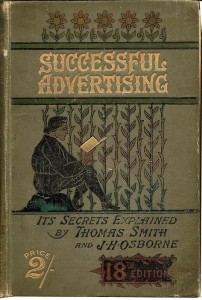 |
I.
The Promotion Mix
 |
Exercise
Communications Mix |
In what
way does Public Relations particularly stand out as
different from the other four methods of
communication?
Post your answer in the
Moodle Discussion Group. |
|
II. Integrated Marketing
Communications
We are moving from an age of mass communication (think Coca-Cola
before the 1990s) to an age that takes advantage of all the media
coming to use for advertisers - more digitally oriented customers,
focused marketing programmes, new technology...
The Need for Integrated Marketing
Communications (IMC)
III. Shaping the Overall Promotion Mix
Just as your Marketing Plan must be
developed with every element in relation to all the others, so a
Promotion Mix must be developed.
Promotion Mix Strategies: Push vs.
Pull
| Does your
company advertise mostly to
retailers to encourage them to
PUSH
your product through the channel to the final consumer?
|
|
or are you going to focus on advertising to
reach
consumers who will then
PULL
your product through the channel?

|
|
| The
small print says that retailers can expect coffee
sales to rise 567% with in-store displays |
|
 |
Exercise
- Plan
Push or Pull |
Will
you use mainly Push or Pull for your Marketing Plan product? Describe what you will do and why.
Post your answer in the
Moodle Discussion Group. |
|
The IMC Process
The combination of the elements of
communication must be consistent with what you are trying to
accomplish. Which market are you going after? What are your
buyers like? What magazines do they read? What are their
demographics? Advertising
may be more important in consumer marketing, while personal sales
is usually more important in industrial marketing.

|
The Communication Mix
must reflect your overall marketing strategy. You
wouldn't advertise a $20,000 Rolex watch in
 Magazine.
Magazine.
See the earlier challenge to
this here |
 |
Exercise
Mad Magazine
LAB?
|
Seriously,
under
what circumstances MIGHT you reasonably
advertise a Rolex watch in Mad Magazine? Think
outside the box; you can't just say, "You can't do it"!
Post your answer in the
Moodle Discussion Group.
If you don't know
what Mad Magazine is, make this a Marketing Lab exercise
and go buy a copy and find out. It was your professor's
favourite magazine when she was a teenager. Do check
this out and think it through; I almost always ask it on
the in-class test! Or, these days you can check it out
online.
|
|
IV. Advertising
| Small and Medium Sized Companies
usually use an In-House Marketing Department; Large Companies use
Outside Agencies, sometimes with an In-House Department as well, or
they may have their own In-House Agency. |
| Agencies vary in size from tiny
boutiques to huge conglomerates like J. Walter Thompson. |
The Top 24
Most
 words in English
words in English
|
|
win
you
yes
now
new
free
sale
love
save
easy
today
safety
health
results
proven
money
limited
benefits
how (to)
deadline
discovery
guarantee
introducing
announcing
|
Setting Advertising Objectives
| Possible Objectives For
Advertising |
Inform
e.g.: describing available services |
 |
Persuade
e.g.: changing buyer perceptions of product
attributes |
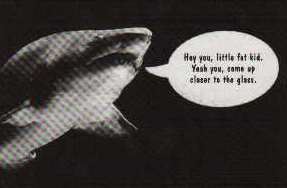
If this is how you think sharks look
at people, you need to take a good look at our
exhibit...
(the shark is saying, "Hey you, little
fat kid! Yeah you, come up closer to the glass") |
Compare
In addition to the three major objectives mentioned
in your text, advertising also can be used to
compare one product to another, as in this ad by
Tripod, an internet advertising company |
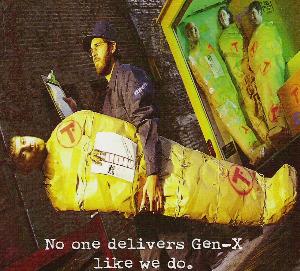 |
Remind
e.g.: maintaining top of mind product awareness |
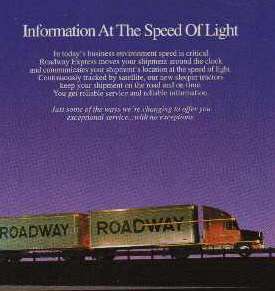 |
 |
Exercise
Advertising Objectives |
Describe
a favourite TV ad of your own that accomplishes one of
these objectives. In your opinion, what makes the
ad effective?
Post your answer in the
Moodle Discussion Group. |
|
Setting the Advertising
Budget
| Method |
Question
to Ask |
Drawbacks |
| Affordable |
How much can we afford to
spend? |
ignores effect of promotion
on sales |
| Percentage of Sales |
What did we make last
year? |
sees sales as a cause of
promotion rather than a result |
| Competitive-Parity |
What's our competition doing? |
assumes your competitor knows
more than you do |
Objective/Task
 probably
best probably
best |
What do we want to
accomplish? |
difficult to directly tie
objectives to specific promotion tasks |
Developing Advertising Strategy
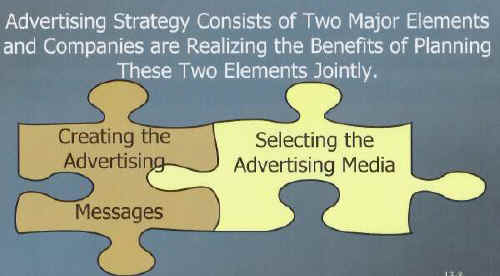 |
You need a good message that can
break through advertising clutter and catch peoples' attention,
positioning the product to meet the consumer's needs with a
creative concept or "Big Idea" that will capture the
essence of what you're trying to communicate. |
Message Strategy and Execution
This involves deciding on what kind of argument you
will make in your promotion. This is the area where I do most of my
academic research. Advertisements can argue for the product in many
different ways
Rational
Logic is our
favourite way of making an argument in
North America and most promotional
messages will be based to at least some
degree in a consistent sensible logical
argument |
Emotional
We've seen a real shift in the last years from almost complete avoidance of fear
appeals to much more active use of them
 |
Exercise
Emotional Advertising |
Why
do you think we're seeing so much more emotional
advertising now?
Post your answer in the
Moodle Discussion Group. |
|
|
Moral
Who decides
whether it's right to air a particular ad
or run a particular promotion campaign?
Censorship should not be needed; companies
and associations of companies try to
police themselves |
| Advanced: Add to this
list of types of arguments made by the
communications process:
Visceral
and Kisceral |
Selecting Advertising Media
You next need to choose the place and voice in which
to present your message. It's not always a matter of how much money you
spend, but more often of where your money will be
most effective.
If you are advertising an expensive tennis racket, a
$15,000 ad in Tennis Life may effectively
reach far more of your target market than a $100,000
ad in Maclean's.
 |
Exercise
- Plan
Type of Media |
Where will it be
most effective to put your promotion for your
marketing plan product? Why?
Post your answer in the
Moodle Discussion Group. |
|
Evaluating Advertising Effectiveness
and Return on Advertising Investment
Aim for Effect Not Just Exposure
- Recall versus Recognition
Imagine I am doing a
Marketing Research study for the new Porsche Boxster.
Imagine I have properly introduced myself and ascertained
that you watched TV last night. Then I ask you
"What ads do you remember seeing last night?"
I'm hoping you'll say
"the Porsche Boxster" This is unaided recall, and
it's the best answer I can hope for; it means you
remembered the company's ad without any help, that
it's right there in the top of your mind (top of
the mind awareness). If you don't remember, I will
ask
|
"Do you remember seeing an ad
about X (or with X, Y, and Z in it)?"
I'm still hoping you'll say yes,
and maybe that it will trigger you to say,
"yes, it was for that new Porsche!" This is aided
recall and it's not as good as unaided recall
but it's better than the next one |
"Do you recognize this ad?"
 |
This is recognition.
I'm hoping you'll say, "yes, I saw it last
night" but it's the least impressive result I
can bring to Porsche to tell them how effective
their ads are
And of course ultimately the company
does not really care who saw their ad no matter how
they remembered it; the company wants to know how
many people went out and bought the product --
measure effect not exposure
|
|
 |
Exercise
Recall |
Unaided
Recall is difficult. Try it right here while you're at
the computer. Think back, can you tell us what ads you
saw last night? (either on TV or on your way home from
somewhere).
Post your answer in the
Moodle Discussion Group.
|
|
Other Advertising Considerations
Organzing for Advertising
This is the area of Advertising that overlaps
what I did in my doctoral dissertation with respect to channels of
distribution. To put it in a few spare words, a company has to
decide whether to hire someone from outside or do the functions
themselves.
International Advertising Decisions
One of the exciting things about teaching at York is having students
who come from all over the world. This section of your text deals with
the problems of international advertising.
 |
Exercise
International Advertising |
Does
anyone who has lived in a country other than Canada have
any stories to share about advertising in other
countries?
Post your answer in the
Moodle Discussion Group. |
|
IV. Public Relations
The Role and Impact of Public
Relations
Building good relations with the company's
various publics by obtaining favourable publicity, building
up a good "corporate image" and handling or
heading off unfavourable rumours, stories, and events,
through the use of news stories, features, press
conferences, annual reports, corporate website, product
publicity, lobbying, and public service. It is often seen as
more believable than advertising.
|
Press
Relations or Agency - creating and placing
newsworthy information in the media |
|
Product
Publicity - publicizing specific products |
|
Public
Affairs - building and maintaining
national or local community relations (sponsoring a
Little League baseball team) |
 |
|
Lobbying
- building and maintaining relations with
legislators and government officials |
|
Investor
Relations - maintaining relationships
with shareholders and others in the financial
community |
|
Development
- maintaining relationships with donors or members
of not-for-profit organizations |
|
Crisis Management
- helping a company in
the media spotlight because of a problem with product,
employees, or business |
Major Public Relations Tools
Chapter 13: Personal Selling and Sales Promotion
I. Personal Selling
Most sales people are well-educated, highly trained
professionals whose main job it is to build and maintain long-term
relationships with customers through two-way personal communication. The sales
force can be manufacturer's representatives or people hired directly by
the firm, and they range from Order-Takers (department store
salesperson) to Order Getters (someone selling a Lear jet). One of the
things that makes them good at their jobs is their ability to really
know their customers and find out what they want and need.
Five Stages in the History of the
Salesperson
"The 5 Stages
of the Salesperson" is adapted from a lecture Professor
Larry Ring used to do when I was a doctoral student at the
University of Toronto. Professor Ring has no idea, because I
never got around to telling him before he moved to William
and Mary College, that he was one of the best professors
I've known and one of my favourites in my doctoral
programme, and I hope that he takes my use of his material
as a tribute to his excellent teaching skills. This story of
the AIDA model is also his.
The AIDA Model
 The AIDA model
is popular in Advertising, and it also gives us a clue to what
makes a successful salesperson. The AIDA model
is popular in Advertising, and it also gives us a clue to what
makes a successful salesperson. |
Awareness
(said loudly as you enter the customer's office)
"Mr. Sheppard, your wastebasket's on fire!!!!!"
Interest
(said in a continual stream, not leaving time for the customer to
interrupt)
"How's the wife and kids? Taking a vacation this year, I know
you've always taken the family to the cottage, lovely up there this time
of year I'd bet. Hey! Last time we talked, I remember you were looking
for a new floor cleaner for the plant?"
Desire
"How would you like to try something that's going to knock your socks
off? It's not officially out on the product line yet, I'm only giving it
to a very few select customers."
Action
"You'll take it! I knew you would! I know you know a
good deal when you seen one, just sign here!"
Also known as
"THE CLOSE" and the worst possible thing you can
say about a salesman, the true test of his manhood,
particularly a salesman when his entire success was (surely
we've moved beyond that?!) measured by how his work day went,
the worst thing you could say about him was

|
 |
Exercise
Sales People-Good or Bad |
Everyone has a "favourite good salesperson" story - what's
yours? From whom did you buy something and felt wonderful
about the purchase mainly because of the salesperson?
Or alternatively, what
is your "worst salesperson" story?
Post your answer in the
Moodle Discussion Group. |
|
The Role of the Sales Force
A company needs to decide whether its sales force will be product
oriented or customer oriented, outside or inside, or a combination of
these.
The Personal Selling Process
|
Prospecting & Qualifying |
|
Preapproach |
|
Approach |
|
Presentation & Demonstration |
|
Handling Objections |
|
Closing |
|
Follow-Up |
From prospecting and qualifying through to the following-up, the
personal selling process is all about getting new customers, and we know
from research that it costs a company roughly 4 times as much to get a
new customer as it does to keep an old one.
II. Sales Promotion
Offers short-term incentives to encourage purchase
or sales of a product or service
Offers reasons to buy NOW. In general, Sales Promotion techniques focus
on customer relationship building.
Sales Promotion Objectives and Tools
Consumer Promotion
Tools
| samples, coupons,
cash refunds, price packs, premiums,
advertising specialties, patronage rewards,
point-of-purchase, contests, sweepstakes,
games |
|
Objective:
increase short-term sales or help build long-term
market share
|

|
Trade Promotion
Tools
| discounts, buying allowances,
merchandise allowances, free
goods, push money, specialty ad items, cooperative
advertising, dealer sales
contests |
|
Objective:
persuade channel members to carry a brand, give it
shelf space, promote a brand in their advertising,
or to push a brand to consumers
|

|
Business
Promotion Tools
| conventions,
trade shows, sales contests, bonuses |
|
Objective:
generate business leads, stimulate purchase, reward
customers, motivate sales people
|

|
 |
Exercise
- Plan
Sales Promotion |
Which
of these three will be most useful to you in your
Marketing Plan?
Post your answer in the
Moodle Discussion Group. |
|
Sales Promotion Decisions
| Size of incentive |
| How to Promote and Distribute the Promotion |
| Timing and Length of Promotion |
| Evaluation |
| Rules and Regulations Governing Sales Promotions |
Relationship Marketing
This is what it's all about in Marketing, what it's always been all
about since the clerk in the country store told Mrs. Jones that he was
expecting a new shipment of calico cloth in on Tuesday that he knew her
daughters would like for new dresses that fall. It's nothing new. It is
simply about meeting the needs of your consumer, knowing them well
enough to know what is of value to them, and putting their needs before
yours, which will, almost always, ensure you a profit.
 |
Exercise
Relationship Marketing |
Remember our early
discussion about Relationship Marketing, back in Unit 1? (my
story about earbags). What do you now know that you
didn't back then that would help you better understand
what makes relationship marketing work?
Post your answer in the
Moodle Discussion Group. |
|
III. Wrapping It Up, Tying It Together
The
promotional tools
are all related. A company may use advertising to promote its
image to the public through corporate or institutional
advertising, which, unlike specific product advertising, promotes the organization
as a whole, while ensuring that Public Relations experts get
stories of their events to the newspapers.
|
 |
 |
Exercise
Benetton
Advanced |
While
this ad appears to deal with social issues, why is it NOT
Social Marketing?
Post your answer in the
Moodle Discussion Group.
If you don't have the
faintest idea and are interested, check the course on
Social
Marketing |
|
Socially Responsible Marketing
Communication
What's Bad About Ads? The only even
quasi-political statement I make when teaching Introductory marketing is
a section I do in this chapter from my own research into sexism and
racism in advertising. I have not yet been able to convert it to the
Internet due to copyright problems with the large number of ads I use,
but you can see it for yourself. Open your eyes and your mind and go
look at ads, in magazines, on TV.
|